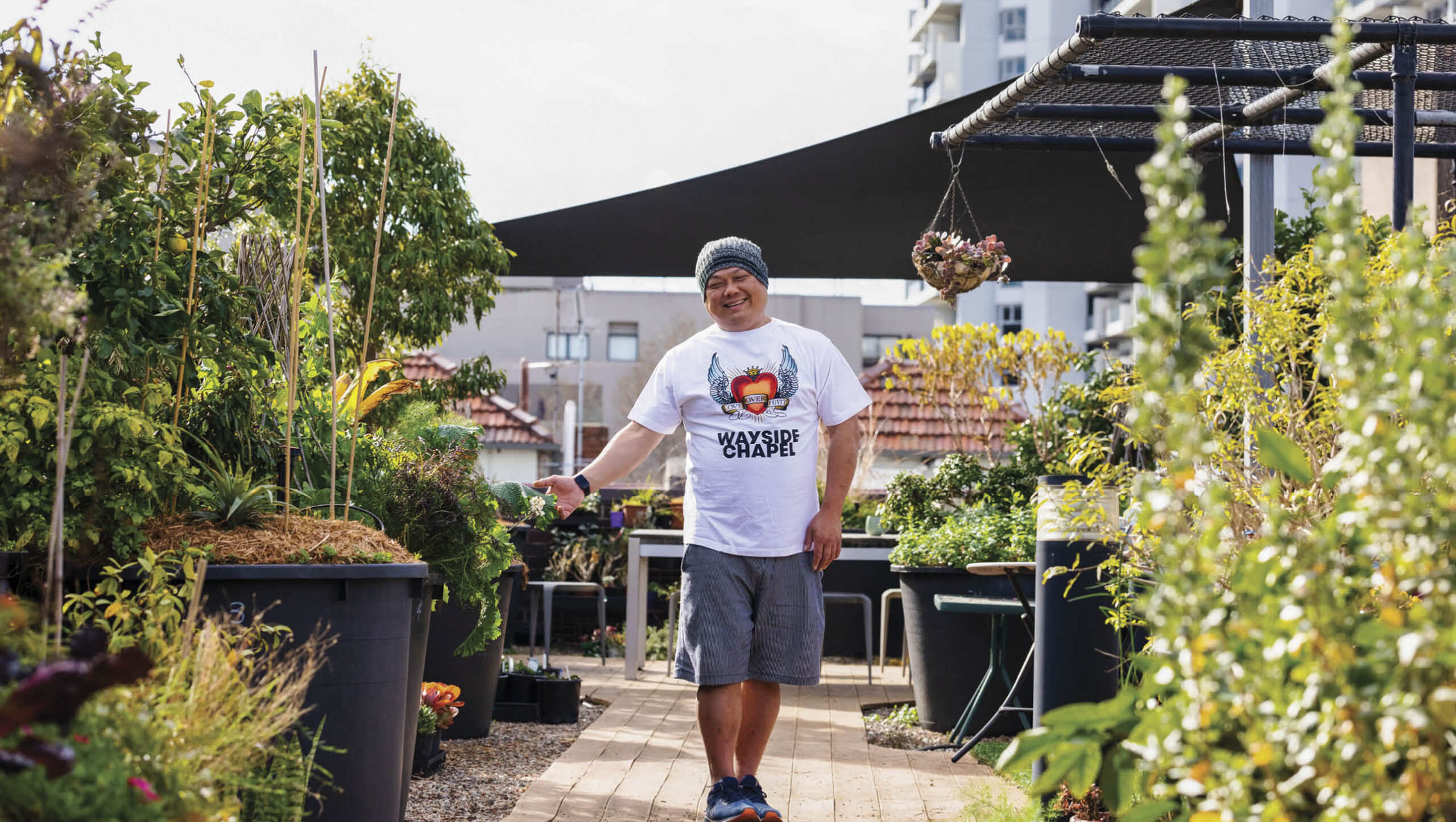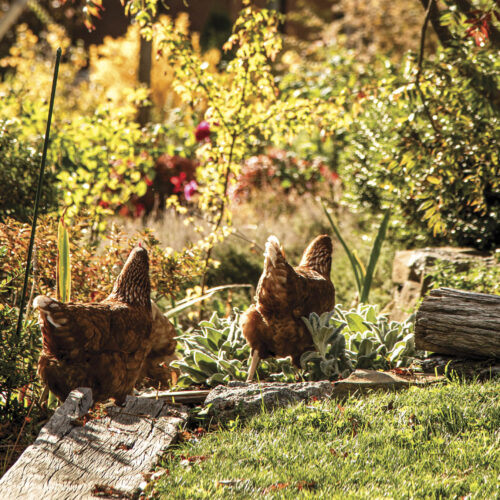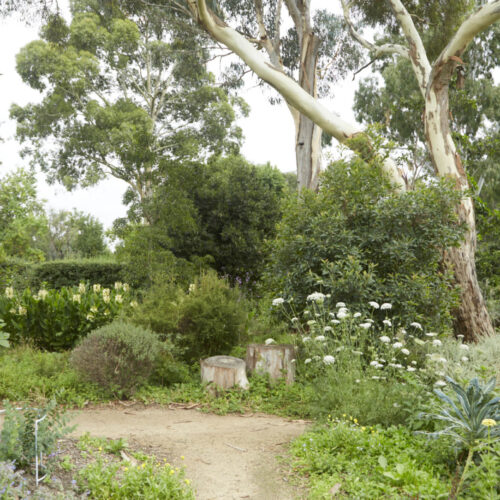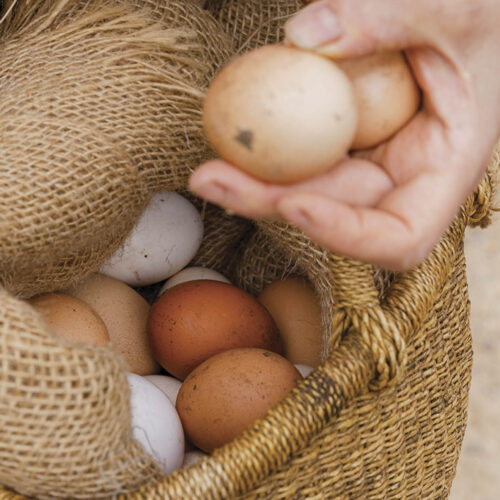Gardening above the fray
2022-11-07T00:17:09+11:00
The Wayside Chapel rooftop garden is an oasis above the busy city, providing a quiet haven for those who need it, writes Leanne Croker.
For many of us, a garden is a place to escape to; time spent there is a chance to forget the busyness of the world outside and enjoy the simplicity of hands in soil and watching things grow. There are others in our community, though, who don’t have a space of their own to retreat to – many don’t even have a home due to the mental health, drug or personal trauma that has destabilised their lives. Often, places like the rooftop gardens at the Wayside Chapel at Kings Cross and Bondi Beach, Sydney, become the only oasis some can turn to.
Since established by the Reverend Ted Noffs in Kings Cross in the early 1960s, the Wayside Chapel has provided a place where people can go to share concerns, voice opinions and find a community, particularly people with nowhere else to go. The rooftop garden, which was installed as part of a major building refurbishment in early 2000s, is one of the places people in need can find connection and respite.
Safe environment
The rooftop garden is a surprisingly quiet space, compared to the noise of the busy streets and the many people below, stopping in to make use of services such as counselling, legal advice, provision of short-term crisis accommodation or just a chat with the staff or fellow visitors. The issues Wayside visitors face are varied and complex, including domestic violence, mental health, homelessness, social isolation, grief and loss, probation and parole.
“The Wayside Chapel garden is a horticultural therapy garden,” says Jon Kingston, who works at the Kings Cross and Bondi Beach gardens two days a week, running classes and activities as well as maintaining the garden with the assistance of volunteers.
“Because of the way legislation works in Australia, there’s not really any horticultural therapists as such because it’s not a recognised profession. Therapeutic Horticulture Australia are advocating government networks for this to change. Here, the idea is that we’re getting visitors to engage with the garden and it’s therapeutic to them, rather than us providing therapy. That’s an important distinction.”
The 200sqm garden is a natural space that grows in the midst of a busy city and gives without asking for much in return.
“A lot of people don’t engage with nature anymore and so we hope the visitors, and staff, who come up here will feel connected to nature through our wild, organic-style garden, even though it’s on a roof.”
A city oasis
The rooftop garden is calm and peaceful, although there’s the white noise of the exhaust fan of the kitchen and traffic noise below.
“When we are doing our mindfulness session at the start of the gardening classes, people tend to tune that out and then you start hearing the sound of the birds around you and less of the city,” Jon says.
“We have a lot of life in the garden, as well as all the flowers and food plants, lots of bees and birds and all that sort of stuff. We see magpies foraging up here quite a bit, and they’re not problematic as they know our faces.”
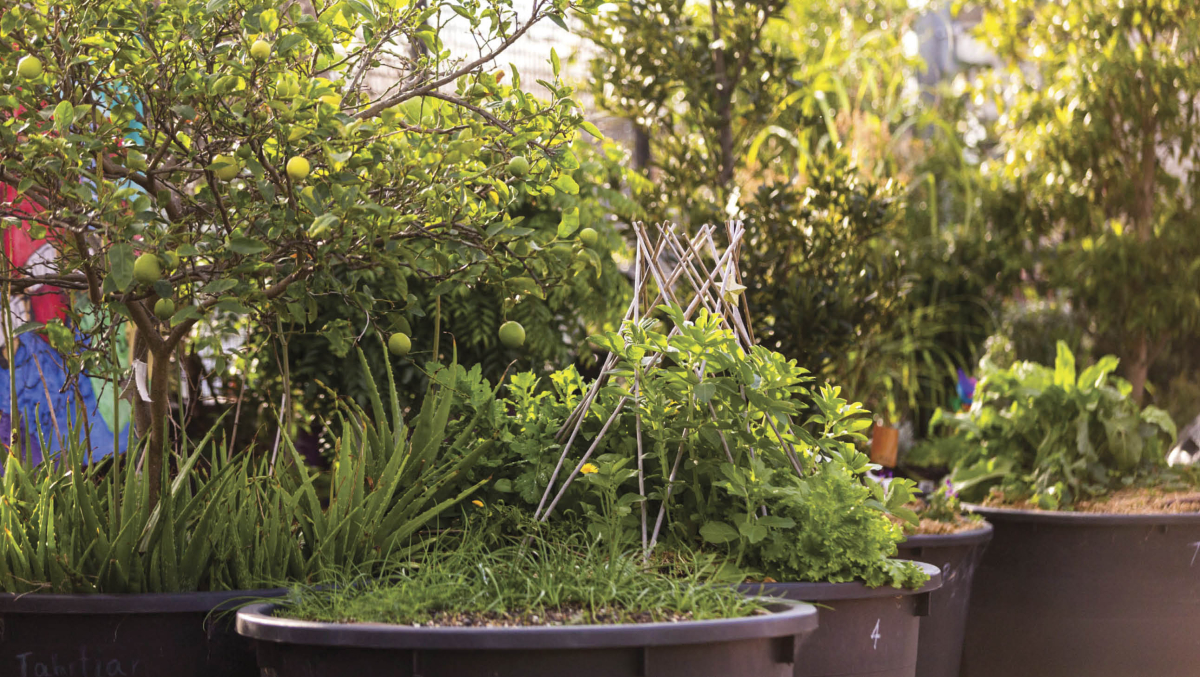
And there’s plenty to attract wildlife, with citrus trees growing in big tubs, and collections of herbs and flowering plants filling pots of various sizes. Herbs include lemon thyme, regular thyme, savory and winter savory, sage, garlic chives – all with a variety of textures and fragrances. In another tub there’s a collection of mints, including spearmint and chocolate mint, which Jon likes to use for tea. Turmeric and ginger are grown in one pot in summer. Trees include lemon myrtle, Myer lemon, Davidson plum and a very happy fig tree, all of which provide plenty of fruit.
There’s very little waste, with compost containers and worm farms used to process anything that comes off the roof and organic scraps from the kitchen.
Something for everyone
Visitors help with the practical aspects of the Wayside Chapel garden, such as processing seeds, storing them, potting them up, planting them out, and then harvesting. Or they may choose to pot up some cuttings, or make a terrarium bowl using some of the many succulents that love the heat of the rooftop.
“We do a lot of cuttings of indoor plants as part of the program for visitors, which means they can also take a plant with them,” Jon says. “If they are living in a car, they can have a companion; if they’re couch surfing it can often act as a sweetener to help them get a few extra nights; or just a ‘thank you for letting me stay, I hope you might welcome me back’.”
There’s always a couple of volunteers to assist with the garden activities, along with a staff member to help with any queries. For example, Jon explains, they might be collecting seeds that have been saved and writing up the names on packets but someone might have literacy issues – the staff member can help with suggestions as to where they can get assistance and do it in a way that is very respectful away from the rest of the group.
A place to just be
“For a lot of visitors, they are caught up in a constant vortex, things are constantly disruptive, with a lot of trauma, ongoing and from the past. All sorts of crazy things going on in their life, so the garden gives them an eye of the storm,” Jon says.
“It’s a place where they can just be themselves for a moment and just remember what being themselves is like. They are not the sum of all those bad things that are going on in their lives. They can be here and express that for an hour and a half and that can give them some resilience to start dealing with some of the issue that are ongoing.”
Jon explains that the rooftop garden is like a re-entry into community.
“When you are homeless you can be ignored, or when you have mental health or drug and alcohol problems you are ignored by people and people actively avoid you and actively don’t look at you – very purposeful thing that can very quickly diminish your self worth. So having the human contact in an environment like this can help people relax and just be themselves.”
Learm more about the Wayside Chapel and what they do here.
This story first appeared in our Early Summer 2022 issue (OG 137). You can get a copy here and learn about futureproofing our homes and gardens, growing pumpkins and the best chooks for laying eggs.

